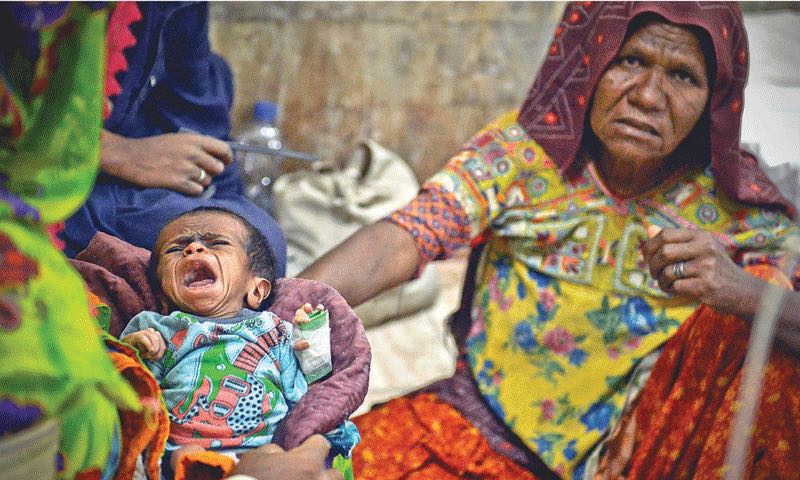As continuing reports of deaths of babies in Tharparkar surged well over the hundred mark, Sindh Health Minister Jam Mehtab Dahar earlier yesterday claimed that, “the media is ‘misreporting’ the number of children’s deaths in the drought-hit region.”
Official estimates record the death toll at 112, with over 100 deaths reported in January alone. But Jam Mehtab maintains the number of deaths is far less.
“In the past month, only 32 children have died,” he said. “Doctors in Thar are complaining that the media is reporting incorrect facts and figures about deaths in the region.”
Parents carrying their ailing children to hospitals are complaining of a lack of proper medication, staff, and facilities. Tharparkar Deputy Commissioner Khuda Dino Shoro, who visited the Civil Hospital in Mithi earlier, said the situation was under control and the government has taken prompt actions to provide healthcare facilities in all units of the district.
The health minister said in agreement: “There are gynaecologists and child specialists posted at every hospital.”
He said doctors in Thar have also been complaining about media’s reporting, which presents misleading numbers.
“One doctor in Thar has to do the work of ten doctors somewhere else. We should be appreciating their performance,” Jam Mehtab added.
But civil society members have expressed their concerns over the increasing death toll, and the government’s failure to provide basic health facilities in remote villages.
Meanwhile, villagers in Thar have been complaining about the lack of clean drinking water. But Mehtab insists that the issue runs much deeper. For example, he said, women and children are more comfortable delivering children in the presence of dais– midwives present at home.
“There are cultural barriers at hand,” he said. “They cannot be changed quickly.”
Meanwhile, the opposition raised hue and cry in the legislature about mismanagement in Thar. Slogans of shame were hurled at the Sindh government for not handling the matter in a timely manner.
A health network in shambles
Health departments in drought-hit Thar have been functioning with minimal facilities and deplorable conditions for many years, despite over 1,700 deaths of children in the past three years alone.
In the past few months, 99 children have lost their lives due to a rise in the spread of waterborne diseases and the lack of immediate healthcare. Officials lament the shortage of doctors, paramedics and health professionals. At least 300 more doctors and hundreds more paramedics are required urgently.
Currently, there are only 141 doctors and only 14 ambulances serving 265 “functional” health units in Thar. Out of these, the health department manages only 92 health units, including six rural health centers, four taluka hospitals, a few dispensaries and the Civil Hospital of Mithi.
But many others are in shambles. The government’s tall claims of providing healthcare facilities to nearly 1.5 million people are questionable, since many of these facilities are left closed and unattended. Dispensaries and Basic Health Units (BHUs) are often bolted shut, and patients cannot go inside.
In some cases, patients are forced to sit on the floor since there is no proper seating arrangement or furniture. The shortage of lady doctors is also a problem for many villagers, especially women with young children.
A crisis for health workers
Villagers across far flung villages of Hothiar, Malanhor Weera, Lakhmiar, Khakhanhar Bajeer, Bangal Rind, Sobhe Jo Tar and Sahooram Paro have made similar complaints.
Sindhu Gurgez, a nurse posted at a dispensary in Hothiar, told Dawn.com that due to poverty and malnutrition, most children, pregnant women and the elderly have contracted various chronic diseases.
Gurgez was posted two months ago at a unit that had been closed until it was taken over by the Health and Nutrition Development Society (HANDS).
Sat Ram Roopani of HANDS said that after the outbreak of diseases, 40 trained nurses and 20 additional staff were deployed at 20 dispensaries in the area to immediately treat children and elders.
Furniture belonging to a closed health units in Islamkot. Meanwhile, a maternity home in the rural health center of Islamkot is not functional due to a shortage of lady doctors. — Photo by the author
Along with HANDS, other groups have been forced to step in and address the need for improved medical assistance. The People’s Primary Healthcare Initiative (PPHI), for example, has been catering to 21 per cent of the Thar area. It hosts 49 facilities, including 18 dispensaries and 31 BHUs.
Another doctor who spoke on the condition of anonymity said because of the lack of functioning health centers, the bulk of the burden has fallen on Civil Hospital in Mithi.
“The hospital is facing a crisis,” he said. “Had rural health centers and dispensaries in other areas been working properly, this could have been avoided.”
He added that 64 doctors, who were appointed on a two-year contract in 2014, are yet to be given extensions despite their protests.
“There is a dire need to send teams of doctors to remote and inaccessible villages to vaccinate children to avoid further fatalities,” Roopani said.
Misusing facilities
Abdul Aleem Soomro, an elder in the village Mithrio Soomro of Islamkot taluka told Dawn.com that one of the dispensaries built in 2007 has never been functional. Doctors or paramedics are yet to be posted to this facility.
The facility was constructed with the intent to treat over 10,000 people in the area. But despite frequent protests by villagers, and assurances from representatives and elected members in Thar, Soomro says the villagers are forced to travel to distant towns to seek treatment for the most common of diseases.
“The dispensaries have not been handed over to the health department,” Soomro says. According to official figures, there are 215 such dispensaries, many of which remain closed.
“They are being used by influential people as sitting quarters.”
The spread of waterborne diseases
Roopani of HANDS observed that the lack of safe drinking water is a problem in a region where villagers are completely dependent on rain. Many diseases break out due to the lack of proper food and the unavailability of safe drinking water.
The senior civil judge at Mithi, who has been posted as the Relief Inspecting Judge and is monitoring the relief operation, said along with distribution of relief items, availability of doctors and staff, and making dispensaries functionary, the provision of safe drinking water should also be made a priority.
“Otherwise, people will continue to mourn the deaths of their children,” he said.
Ali Akbar Rahimoon, CEO of Association for Water Applied and Renewable Energy (Aware), agreed.
“Children will continue to die until these issues are addressed,” he said.
No clean drinking water
Dr Mohan Lal, a child specialist in Mithi Civil Hospital, said waterborne diseases related to dysentery, typhoid, diarrhea and gastro have directly lead to an increase in child deaths.
Meanwhile, villagers have also been protesting the lack of clean drinking water. They are demanding local governments to install more reverse osmosis (RO) plants and provide alternative options for clean drinking water across the 2,500 villages of Thar.
Ali Akbar Kumbhar, a resident of the village Mohario of Diplo taluk, said hundreds of villagers are being forced to drink “blackish water they gather from deep wells.”
This water is laden with arsenic and fluoride, and results in the spread of chronic diseases. Others have strongly condemned local officials for not looking after the upkeep of the RO plants after they were installed.
“Since droughts are frequent, there is a dire need to install more RO plants,” Kumbhar said.






